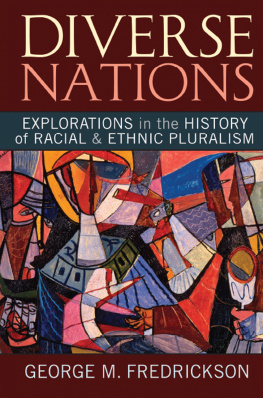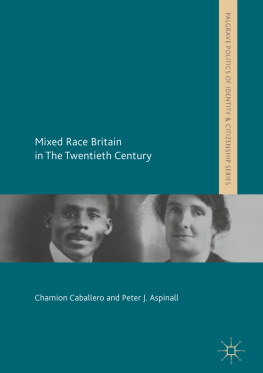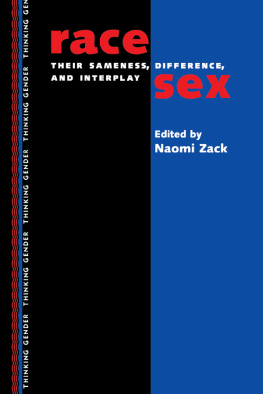Mixed-Race in the US and UK
CRITICAL MIXED-RACE STUDIES
Edited by Shirley Anne Tate, University of Alberta, Canada.
This series adopts a critical, interdisciplinary perspective to the study of mixed-race. It will showcase ground-breaking research in this rapidly emerging field to publish work from early career researchers as well as established scholars. The series will publish short books, monographs and edited collections on a range of topics in relation to mixed-race studies and include work from disciplines across the Humanities and Social Sciences including Sociology, History, Anthropology, Psychology, Philosophy, History, Literature, Postcolonial/Decolonial Studies and Cultural Studies.
Editorial Board: Suki Ali, LSE, UK; Ginetta Candelario, Smith College, USA; Michele Elam, Stanford University, USA; Jin Haritaworn, University of Toronto, Canada; Rebecca King ORiain, Maynooth University, Ireland; Ann Phoenix, Institute of Education, University of London, UK; and Rhoda Reddock, University of the West Indies, Trinidad & Tobago
Previously Published:
Remi Joseph-Salisbury, Black Mixed-Race Men: Transatlanticity, Hybridity and Post-Racial Resilience Winner of the 2019 BSA Philip Abrams Prize
Forthcoming in this series:
Paul Ian Campbell, Identity Politics, Mixed-Race and Local Football in 21st Century Britain: Mix and Match
Shirley Anne Tate, Decolonizing Sambo: Transculturation, Fungibility and Black and People of Colour Futurity
Mixed-Race in the US and UK: Comparing the Past, Present, and Future
BY
JENNIFER PATRICE SIMS
University of Alabama in Huntsville, US
and
CHINELO L. NJAKA
Peckham Rights! and Independent Social Researcher, UK
United Kingdom North America Japan India Malaysia China
Emerald Publishing Limited
Howard House, Wagon Lane, Bingley BD16 1WA, UK
First edition 2020
Copyright Jennifer Patrice Sims and Chinelo L. Njaka, 2020. Published under an exclusive licence.
Reprints and permissions service
Contact:
No part of this book may be reproduced, stored in a retrieval system, transmitted in any form or by any means electronic, mechanical, photocopying, recording or otherwise without either the prior written permission of the publisher or a licence permitting restricted copying issued in the UK by The Copyright Licensing Agency and in the USA by The Copyright Clearance Center. Any opinions expressed in the chapters are those of the authors. Whilst Emerald makes every effort to ensure the quality and accuracy of its content, Emerald makes no representation implied or otherwise, as to the chapters suitability and application and disclaims any warranties, express or implied, to their use.
British Library Cataloguing in Publication Data
A catalogue record for this book is available from the British Library
ISBN: 978-1-78769-554-2 (Print)
ISBN: 978-1-78769-553-5 (Online)
ISBN: 978-1-78769-555-9 (Epub)
For Chinyere Ike, Gretha, and all the loved ones we lost along the way.
Contents
List of Tables and Figures
Acknowledgements
List of Tables and Figures
Chapter 2
Appendix
Acknowledgements
Thank you to Shirley Tate, Helen Beddow, Philippa Grand, Rachel Ward, Charlotte Wilson, Alice Ford, Sophie Darling, Sophie Barr, and Rajachitra. S for their work at Emerald. For reading draft chapters and providing incredibly helpful feedback we would like to thank Jeffrey Bayne, David Brunsma, Cabell Hankinson Gathman, Remi Joseph-Salisbury, Danielle Lemi, Danielle McMillian, Ijeoma Njaka, Brittany Sims, Miri Song, Christina Steidl, Myra Washington, and Paul Wright. Jenn would also like to thank her interviewees for their willingness to share their experiences; Whitney Laster Pirtle for her text message support; Erin Reid and Micah Bonds for their lightning-fast administrative assistance; and her family and friends, especially Roxie and Malcolm, for their unconditional love. Finally, Chinelo would like to thank her research participants for giving their time and sharing their perspectives; her family husband, parents, sisters and in-laws; and friends especially India-Alana Doris and Natoyah Epailly for their unceasing support and encouragement during the writing of this book.
Chapter 1
Introduction: The Past, Present, and Future of Mixed-Race People in the United States and United Kingdom
So, can I ask, where are you from?
Yeah, the United States.
Oh yeah? Whereabouts?
A state called Tennessee. Its in the south.
And your parents too?
My dad yes. My mom is from another southern state, South Carolina.
Hmm were they born there?
Um, yes .
Ten years ago, London South Bank University and London School of Economics jointly hosted a series of one-day workshops on mixed-race scholarship in the UK. The above exchange took place between a UK-based attendee and the first author, who was a US PhD student at the time. It would take another couple of trips across the pond before the underlying meaning and theoretical significance of Where are you from? became clear to her.
Like its US counterpart What are you, a question with which the first author was all too familiar, the UK query Where are you from? is a racialised question. The workshop attendee no more wanted to know the home state of the first authors parents than people in the US wanted answers such as a human being when they asked What are you? In both cases, the question seeks a racial answer. Im mixed-race, Im Black, Im from Birmingham but my mum is from India and dad is from Scotland are the types of responses askers are seeking.
Scientists know that races are not biologically predetermined subdivisions of humans but are instead socially constructed groupings. Part of racialised social construction happens at the structural level in the prominence of race in laws, policies, and other types of legislative and political practices and thought. In other words, it is institutional in quality.
Another part of racial groups social construction is at the micro-levels of interaction and symbolism. Regarding the latter, for example, race being socially constructed means that collective ideas have developed about what members of different races look like. Ideas of race-specific physical features abound: Blacks have wide noses, Whites have light skin, Native Americans have high cheek bones, and East Asians have almond-shaped eyes. How, then, does one racially classify a PhD student who has a wide nose, light skin, and almond shaped eyes?
Even when innocently intended, questions such as What are you? reveal the observers racialised gaze,
The Simultaneous Emergence of Critical Mixed Race Studies in the US and UK
Over the past 30 years, social scientists and activists in the US and UK have sought to bring to light the uniquely racialised experiences of mixed-race people. Numerous contemporary mixed-race anthologies exploring identity and various lived experiences stemming from this racialised category were published in the 1990s and early 2000s.







